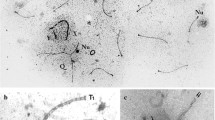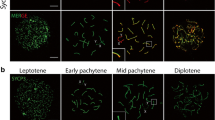Abstract
The XY body from spermatocytes of the rodent Galea musteloides shows progressive changes of the synaptonemal complex (SC) axes and the X-chromatin during pachynema. There is a gross thickening of the X-axis and the formation of a large X chromosome loop at mid and late pachytene stages. The SC proteins synaptonemal complex protein 3 (SYCP3), synaptonemal complex protein 1, and synaptonemal complex central element protein 3 and the proteins breast cancer 1, MutL homolog 1 (MLH1), and radiation-repair 51 (related to meiotic processes), the cohesin structural maintenance of chromosome 3, the centromeric protein (with CREST antibody), and the silenced chromatin (with phosphorylated (139ph) H2A histone family, member X (γ-H2AX) antibody) were analyzed in this XY body. The thick X-axis, including the interstitial loop, becomes formed by four to six laminae showing a cross-striation with a periodicity of about 20 nm. The whole length of the gross X-axis shows no significant changes during pachynema, but the interstitial chromatin of the X chromosome and the X centromere are included in the large loop, and it becomes separated from the SC. A conventional SC formed by the Y-axis, a central region and a thin lateral element originally corresponding to the X-axis, remains undisturbed up to the end of pachynema. A single MLH1 focus develops either at the distal or the proximal region of the loop end attached to the conventional SC. The chromatin surrounding the thickened axis is labeled with γ-H2AX. It is shown that most of the SYCP3 protein associated with the X chromosome loop is not involved in the SC maintenance, but it is located with the cohesin axis separated from the SC proper.




Similar content being viewed by others
Abbreviations
- ATR:
-
Ataxia telangiectasia and Rad3 related
- BRCA1:
-
Breast cancer 1
- CR:
-
Central region
- CREST:
-
Calcinosis, Raynaud's phenomenon, esophageal dysmotility, sclerodactyly, and telangiectasia
- DNA:
-
Deoxyribonucleic acid
- EM:
-
Electron microscopy
- IFI:
-
Indirect immunofluorescence
- LE:
-
Lateral element
- MLH1:
-
MutL homolog 1
- MSCI:
-
Meiotic sex chromosome inactivation
- MSUC:
-
Meiotic silencing of unsynapsed chromatin
- PAR:
-
Pseudoautosomal region
- PBS:
-
Phosphate-buffered saline
- PTA:
-
Phosphotungstic acid
- RAD51:
-
Radiation-repair 51
- SC:
-
Synaptonemal complex
- SMC3:
-
Structural maintenance of chromosome 3
- SYCP1:
-
Synaptonemal complex protein 1
- SYCP3:
-
Synaptonemal complex protein 3
- SYCE3:
-
Synaptonemal complex central element protein 3
- γ-H2AX:
-
Phosphorylated (Ser139) histone 2, A.X
References
Bojko M (1990) Synaptic adjustment of inversion loops in Neurospora crassa. Genetics 124(3):593–598
Burgoyne PS, Mahadevaiah SK, Turner JM (2009) The consequences of asynapsis for mammalian meiosis. Nat Rev Genet 10:207–216
Carpenter AT (1987) Gene conversion, recombination nodules, and the initiation of meiotic synapsis. Bioessays 6(5):232–236
De Boer, P, Jong JH (1989) Chromosome pairing and fertility in mice. In: Gillies C.B. (ed.) Fertility and chromosome pairing: recent studies in plants and animals. CRC, Boca Raton, pp. 37–76
de Vries FAT, de Boer E, van den Bosch M et al (2005) Mouse Sycp1 functions in synaptonemal complex assembly, meiotic recombination, and XY body formation. Genes Dev 19(11):1376–1389
del Mazo J, Gil-Alberdi L (1986) Multistranded organization of the lateral elements of the synaptonemal complex in the rat and mouse. Cytogenet Cell Genet 41(4):219–224
Echeverría OM, Benavente R, Ortiz R, Vázquez-Nin GH (2003) Ultrastructural and immunocytochemical analysis of the XY body in rat and guinea pig. Eur J Histochem 47(1):45–54
Fraune J, Alsheimer M, Volff JN et al (2012) Hydra meiosis reveals unexpected conservation of structural synaptonemal complex proteins across metazoans. Proc Natl Acad Sci U S A 109(41):16588–16593
Goldstein P (1987) Multiple synaptonemal complexes (polycomplexes): origin, structure and function. Cell Biol Int Rep 11(11):759–796
Henzel JV, Nabeshima K, Schvarzstein M, Turner BE, Villeneuve AM, Hillers KJ (2011) An asymmetric chromosome pair undergoes synaptic adjustment and crossover redistribution during Caenorhabditis elegans meiosis: implications for sex chromosome evolution. Genetics 187(3):685–699
Hernández-Hernández A, Vázquez-Nin GH, Echeverría OM, Recillas-Targa F (2009) Chromatin structure contribution to the synaptonemal complex formation. Cell Mol Life Sci 66(7):1198–1208
Johnson ME, Rowsey RA, Shirley S, Vandevoort C, Bailey J, Hassold T (2013) A specific family of interspersed repeats (SINEs) facilitates meiotic synapsis in mammals. Mol Cytogenet 6(1):1
Khalil AM, Boyar FZ, Driscoll DJ (2004) Dynamic histone modifications mark sex chromosome inactivation and reactivation during mammalian spermatogenesis. Proc Natl Acad Sci U S A 101(47):16583–16587
Li XC, Bolcun-Filas E, Schimenti JC (2011) Genetic evidence that synaptonemal complex axial elements govern recombination pathway choice in mice. Genetics 189(1):71–82
Moens PB, Marcon E, Shore JS, Kochakpour N, Spyropoulos B (2007) Initiation and resolution of interhomolog connections: crossover and noncrossover sites along mouse synaptonemal complexes. J Cell Sci 120(Pt 6):1017–1027
Monesi V (1965) Differential rate of ribonucleic acid synthesis in theautosomes and sex chromosomes during male meiosis in the mouse. Chromosoma 17(1):11–21
Moses MJ (1977) Synaptonemal complex karyotyping in spermatocytes of the Chinese hamster (Cricetulus griseus). II. Morphology of the XY pair in spread preparations. Chromosoma 60(2):127–137
Moses MJ, Poorman PA, Roderick TH, Davisson MT (1982) Synaptonemal complex analysis of mouse chromosomal rearrangements. IV. Synapsis and synaptic adjustment in two paracentric inversions. Chromosoma 84(4):457–474
Murdoch B, Owen N, Stevense M et al (2013) Altered cohesin gene dosage affects mammalian meiotic chromosome structure and behavior. PLoS Genet 9(2):e1003241
Page J, de la Fuente R, Gómez R et al (2006) Sex chromosomes, synapsis, and cohesins: a complex affair. Chromosoma 115(3):250–259
Page J, de la Fuente R, Manterola M et al (2012) Inactivation or non-reactivation: what accounts better for the silence of sex chromosomes during mammalian male meiosis? Chromosoma 121(3):307–326
Pelttari J, Hoja MR, Yuan L et al (2001) A meiotic chromosomal core consisting of cohesin complex proteins recruits DNA recombination proteins and promotes synapsis in the absence of an axial element in mammalian meiotic cells. Mol Cell Biol 21(16):5667–5677
Reeves A (2001) MicroMeasure: a new computer program for the collection and analysis of cytogenetic data. Genome 44(3):439–443
Revenkova E, Eijpe M, Heyting C et al (2004) Cohesin SMC1 beta is required for meiotic chromosome dynamics, sister chromatid cohesion and DNA recombination. Nat Cell Biol 6(6):555–562
Schimenti J (2005) Synapsis or silence. Nat Genet 37(1):11–13
Sciurano RB, Solari AJ (2013) Ultraestructural and immunofluorescent methods for the study of XY body as a biomarker. In: Stockert, Espada, Blázquez-Castro (eds.) Functional Analysis of DNA and Chromatin, Methods in Molecular Biology. Humana Press, USA (in press)
Sciurano RB, Rahn MI, Rey-Valzacchi G, Coco R, Solari AJ (2012) The role of asynapsis in human spermatocyte failure. Int J Androl 35(4):541–549
Solari AJ (1970) The spatial relationship of the X and Y chromosomes during meiotic prophase in mouse spermatocytes. Chromosoma 29(2):217–236
Solari AJ (1974) The behaviour of the XY pair in mammals. Int Rev Cytol 38:273–317
Solari AJ (1980) Synaptonemal complexes and associated structures in microspread human spermatocytes. Chromosoma 81:315–337
Solari AJ (1994) Sex chromosomes and sex determination in vertebrates. CRC, Boca Raton, 308 p
Solari AJ, Rahn MI (2005) Fine structure and meiotic behaviour of the male multiple sex chromosomes in the genus Alouatta. Cytogenet Genome Res 108(1–3):262–267
Solari AJ, Rey VG (1997) The prevalence of a YY synaptonemal complex over XY synapsis in an XYY man with exclusive XYY spermatocytes. Chromosom Res 5(7):467–474
Solari AJ, Ponzio R, Rey VG (1991) Synaptonemal complex karyotyping in an oligospermic patient with heterochromatin duplication in chromosome # 9. Medicina 51(3):217–221 (Buenos Aires)
Solari AJ, Merani MS, Burgos MH (1993) Dissociation of the synaptonemal complex in the XY body of Galea musteloides (Rodentia, Caviidae). Biocell 17:25–37
Turner JM (2007) Meiotic sex chromosome inactivation. Development 134(10):1823–1831
Turner JMA, Mahadevaiah SK, Fernandez-Capetillo O, Nussenzweig A, Xu X, Deng C-X, Burgoyne PS (2005) Silencing of unsynapsed meiotic chromosomes in the mouse. Nat Genet 37:41–47
Yuan L, Pelttari J, Brundell E et al (1998) The synaptonemal complex protein SCP3 can form multistranded, cross-striated fibers in vivo. J Cell Biol 142(2):331–339
Acknowledgments
The able help of Lic C. Deparci is sincerely thanked. We are also very grateful to Prof. M. Alsheimer (University of Würzburg, Germany) for the generous gift of SYCE3 antibody and P.J. Moens† and B. Spyropoulus (York University, Canada) for SYCP1 antibody. We specially thank Prof. Dr. A. Brusco and Eng. Lisandro Anton from LANAIS' service (CONICET). This work was supported by grants from UBACYT 20020100100030 (AJS) and PICT-2010-2718 (RBS).
Author information
Authors and Affiliations
Corresponding author
Additional information
Responsible editor: Walther Traut
Rights and permissions
About this article
Cite this article
Sciurano, R.B., Rahn, I.M., Cavicchia, J.C. et al. Dissociation of the X chromosome from the synaptonemal complex in the XY body of the rodent Galea musteloides . Chromosome Res 21, 753–763 (2013). https://doi.org/10.1007/s10577-013-9379-3
Received:
Revised:
Accepted:
Published:
Issue Date:
DOI: https://doi.org/10.1007/s10577-013-9379-3




